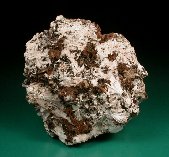Thumbnails

Adamsite crystals
© Doug Merson

Adamsite crystals
© Stephan Wolfsried

Huge cabinet 18 x 14cm
of adamsite-(Y)
© Gilles Haineault
NaY(CO · 6H
Formerly UK-96 and UK-106, adamsite was found in a large alkaline pegmatite dike in the south corner of the Poudrette quarry. It was first collected by Gilles Haineault in 1992 and designated UK-96. A good deal of material was collected in 1998 by various collectors, including the Horvaths and Peter Tarassoff who provided the type material which was designated as UK-106.
It is a very late-stage, low temperature, hydrothermal phase in cavities in an alkaline pegmatite dike in the nepheline syenite associated with a large number of species.
PHYSICAL CHARACTERISTICS:
Color is usually colourless to white, sometimes pale pink.
Luster is vitreous.
Diaphaneity is transparent to translucent.
Crystal System is triclinic; 1.
Crystal Habits flattened acicular to fibrous crystals to 2.5cm,
usually forming spherical groups of radiating crystals.
Cleavage: {001} is perfect, (100) and (010) are good.
Fracture is (??).
Hardness is 3.
Specific Gravity is approximately 2.27 g/cm
Streak is white.
Associated Minerals include aegirine, albite, analcime, calcite,
catapleiite, donnayite, elpidite, epididymite, eudialyte, eudidymite,
fluorite, franconite, gaidonnayite, galena, genthelvite, gonnardite,
horváthite, kupletskite, leifite, microcline, molybdenite, narsarsukite,
natrolite, nenadkevichite, petersenite, polylithionite, pyrochlore,
quartz, rhodochrosite, sabinaite, sérandite, siderite, sphalerite and
thomasclarkite.
Distinguishing Features: Non-fluorescent, effervesces in 10% HCl.
Origin: Named in 2000 after Frank Dawson Adams (1859-1942),
Canadian geology professor at McGill University, Montreal.
CLASSIFICATION:
Dana System
# 15.4.8.1
Strunz Classification
# V/D.03.02
REFERENCES:
CanMin 38:1457-1466 (2000)
DISTRIBUTION AND RARITY AT MONT SAINT-HILAIRE:
MSH
¤¤¤
